Toward a Permafrost Vulnerability Index for Critical Infrastructure, Community Resilience and National Security
Abstract
:1. Introduction
1.1. Effects of Thawing Permafrost on Arctic Communities
1.2. National Security Implications of Permafrost Thaw
1.3. Evaluating Risk, Vulnerability, and Resilience
1.4. Composite Indices: A Community Snapshot
1.5. Integrative Indices: Local Trajectory Assessments
2. Methods
2.1. The Permafrost Vulnerability Index: A System Trajectory over Space
2.2. Vulnerability as a Function of Space
2.3. Formalized Conception of PVI
2.4. Community Observation Selection
- Critical Infrastructure;
- Human Health and Safety;
- Subsistence and Shoreline Use;
- Land Use/Geograpic Location;
- Percentage of Population Affected;
- Housing Distribution;
- Environmental Threat;
- Cultural Importance;
- Commercial Infrastructure
2.5. Selection of Geographic Features
2.6. PVI Co-Design
2.7. PVI Construction
- Create quantitative scores for the 186 communities under study based on the Denali commission and AWRVI results;
- From these scores and the community locations, create an estimative raster surface over the study area for the Denali commission and AWRVI results (one for each) using IDW, which reflects the interactions of their systems over space (2 total raster surfaces);
- Aggregate the two rasters to obtain a single estimative surface representing ;
- Generate quantitative scores for each geographic feature within the 22 infrastructure types;
- Using these scores, calculate the effects of the geographic features on the communities under study using IDW;
- Generate one estimative raster surface for the effects of each of the 22 infrastructure types, as found in the preceding step (22 total raster surfaces);
- Aggregate the rasters from step six by category, then sum the six category rasters to create a single estimative surface representing ;
- Multiply these rasters element-wise to obtain a single raster representing the estimated PVI over the state of Alaska, and extract the values at the locations of the communities to obtain the community PVIs.
2.7.1. Step 1: Scoring of Communities
2.7.2. Steps 2 and 3: Generating and Aggregating the Community Rasters
2.7.3. Step 4: Scoring the Geographic Features of Infrastructure Types
2.7.4. Steps 5, 6, and 7: Calculating the Effects of Infrastructure on Communities Using IDW, Generating Estimative Rasters, and Aggregation to a Single Raster
2.7.5. Step 8: Creating the PVI Raster and Extracting the PVI for Each Community
2.8. PVI for Military Facilities
3. Results
4. Discussion
Author Contributions
Funding
Institutional Review Board Statement
Informed Consent Statement
Data Availability Statement
Acknowledgments
Conflicts of Interest
Abbreviations
| ACCI | Arctic Climate Change Index |
| AWRVI | Arctic Water Resources Vulnerability Index |
| HADR | Humanitarian Assistance and Disaster Response |
| IDW | Inverse Distance Weighting |
| PVI | Permafrost Vulnerability Index |
| SAR | Search and Rescue |
References
- National Research Council of Canada. Glossary of Permafrost and Related Ground-Ice Terms; Number 142 in Technical Memorandum; National Research Council: Ottawa, ON, Canada, 1988.
- Biskaborn, B.K.; Smith, S.L.; Noetzli, J.; Matthes, H.; Vieira, G.; Streletskiy, D.A.; Schoeneich, P.; Romanovsky, V.E.; Lewkowicz, A.G.; Abramov, A.; et al. Permafrost is warming at a global scale. Nat. Commun. 2019, 10, 264. [Google Scholar] [CrossRef] [PubMed]
- McKenzie, J.M.; Kurylyk, B.L.; Walvoord, M.A.; Bense, V.F.; Fortier, D.; Spence, C.; Grenier, C. Invited perspective: What lies beneath a changing Arctic? Cryosphere 2021, 15, 479–484. [Google Scholar] [CrossRef]
- Melnikov, V.P.; Osipov, V.I.; Brouchkov, A.V.; Falaleeva, A.A.; Badina, S.V.; Zheleznyak, M.N.; Sadurtdinov, M.R.; Ostrakov, N.A.; Drozdov, D.S.; Osokin, A.B.; et al. Climate warming and permafrost thaw in the Russian Arctic: Potential economic impacts on public infrastructure by 2050. Nat. Hazards 2022, 112, 231–251. [Google Scholar] [CrossRef]
- Hjort, J.; Karjalainen, O.; Aalto, J.; Westermann, S.; Romanovsky, V.E.; Nelson, F.E.; Etzelmüller, B.; Luoto, M. Degrading permafrost puts Arctic infrastructure at risk by mid-century. Nat. Commun. 2018, 9, 5147. [Google Scholar] [CrossRef] [PubMed]
- Lantz, T.C.; Kokelj, S.V. Increasing rates of retrogressive thaw slump activity in the Mackenzie Delta region, N.W.T., Canada. Geophys. Res. Lett. 2008, 35, L06502. [Google Scholar] [CrossRef]
- Lewkowicz, A.G.; Way, R.G. Extremes of summer climate trigger thousands of thermokarst landslides in a High Arctic environment. Nat. Commun. 2019, 10, 1329. [Google Scholar] [CrossRef]
- Hjort, J.; Streletskiy, D.; Doré, G.; Wu, Q.; Bjella, K.; Luoto, M. Impacts of permafrost degradation on infrastructure. Nat. Rev. Earth Environ. 2022, 3, 24–38. [Google Scholar] [CrossRef]
- Liew, M.; Xiao, M.; Farquharson, L.; Nicolsky, D.; Jensen, A.; Romanovsky, V.; Peirce, J.; Alessa, L.; McComb, C.; Zhang, X.; et al. Understanding Effects of Permafrost Degradation and Coastal Erosion on Civil Infrastructure in Arctic Coastal Villages: A Community Survey and Knowledge Co-Production. J. Mar. Sci. Eng. 2022, 10, 422. [Google Scholar] [CrossRef]
- Baltzer, J.L.; Veness, T.; Chasmer, L.E.; Sniderhan, A.E.; Quinton, W.L. Forests on thawing permafrost: Fragmentation, edge effects, and net forest loss. Glob. Chang. Biol. 2014, 20, 824–834. [Google Scholar] [CrossRef]
- Mamet, S.D.; Chun, K.P.; Kershaw, G.G.L.; Loranty, M.M.; Peter Kershaw, G. Recent Increases in Permafrost Thaw Rates and Areal Loss of Palsas in the Western Northwest Territories, Canada: Non-linear Palsa Degradation. Permafr. Periglac. Process. 2017, 28, 619–633. [Google Scholar] [CrossRef]
- Mann, P.J.; Strauss, J.; Palmtag, J.; Dowdy, K.; Ogneva, O.; Fuchs, M.; Bedington, M.; Torres, R.; Polimene, L.; Overduin, P.; et al. Degrading permafrost river catchments and their impact on Arctic Ocean nearshore processes. Ambio 2022, 51, 439–455. [Google Scholar] [CrossRef] [PubMed]
- Gartler, S.; Larsen, J.N.; Ingimundarson, J.H.; Schweitzer, P.; Povoroznyuk, O.; Meyer, A. A Risk Analysis Framework: Key Risks from Permafrost Thaw in Arctic Coastal Areas. 2022. Available online: https://ui.adsabs.harvard.edu/abs/2022EGUGA..24.7937G/abstract (accessed on 18 August 2023).
- Kahn, S. It Takes a Village: Repurposing Takings Doctrine to Address Melting Permafrost in Alaska Native Towns. Alsk. Law Rev. 2022, 39, 105–138. [Google Scholar]
- Timlin, U.; Meyer, A.; Nordström, T.; Rautio, A. Permafrost thaw challenges and life in Svalbard. Curr. Res. Environ. Sustain. 2022, 4, 100122. [Google Scholar] [CrossRef]
- Beccari, B. A Comparative Analysis of Disaster Risk, Vulnerability and Resilience Composite Indicators. PLoS Curr. 2016, 8, ecurrents. [Google Scholar] [CrossRef] [PubMed]
- Walvoord, M.A.; Striegl, R.G. Complex Vulnerabilities of the Water and Aquatic Carbon Cycles to Permafrost Thaw. Front. Clim. 2021, 3, 730402. [Google Scholar] [CrossRef]
- Wolken, G.J.; Liljedahl, A.K.; Brubaker, M.; Coe, J.A.; Fiske, G.; Christiansen, H.H.; Jacquemart, M.; Jones, B.M.; Kääb, A.; Løvholt, F.; et al. Glacier and Permafrost Hazards. Arctic Rep. Card 2021, 21, 13. [Google Scholar] [CrossRef]
- Versen, J.; Mnatsakanyan, Z.; Urpelainen, J. Concerns of climate intervention: Understanding geoengineering security concerns in the Arctic and beyond. Clim. Chang. 2022, 171, 27. [Google Scholar] [CrossRef]
- Chalecki, E.L. He who would rule: Climate change in the Arctic and its implications for U.S. national security. J. Public Int. Aff. 2007, 18, 204–222. [Google Scholar]
- Strawa, A.W.; Latshaw, G.; Farkas, S.; Russell, P.; Zornetzer, S. Arctic Ice Loss Threatens National Security: A Path Forward. Orbis 2020, 64, 622–636. [Google Scholar] [CrossRef]
- Åtland, K. The Security Implications of Climate Change in the Arctic Ocean. In Environmental Security in the Arctic Ocean; Berkman, P.A., Vylegzhanin, A.N., Eds.; NATO Science for Peace and Security Series C: Environmental Security; Springer: Dordrecht, The Netherlands, 2013; pp. 205–216. [Google Scholar] [CrossRef]
- Crépin, A.S.; Karcher, M.; Gascard, J.C. Arctic Climate Change, Economy and Society (ACCESS): Integrated perspectives. Ambio 2017, 46, 341–354. [Google Scholar] [CrossRef]
- Kraska, J. Arctic Security in an Age of Climate Change; Cambridge University Press: Cambridge, UK, 2011. [Google Scholar]
- Ritchie, M.; Frazier, T.; Johansen, H.; Wood, E. Early climate change indicators in the Arctic: A geographical perspective. Appl. Geogr. 2021, 135, 102562. [Google Scholar] [CrossRef]
- Box, J.E.; Colgan, W.T.; Christensen, T.R.; Schmidt, N.M.; Lund, M.; Parmentier, F.J.W.; Brown, R.; Bhatt, U.S.; Euskirchen, E.S.; Romanovsky, V.E.; et al. Key indicators of Arctic climate change: 1971–2017. Environ. Res. Lett. 2019, 14, 045010. [Google Scholar] [CrossRef]
- Dogulu, N.; Karagiannis, G.M.; Synolakis, C.E.; Yalciner, A.; Necmioglu, O.; Sozdinler, C.O. Report on Institutional Plans, Operative Response Capacities and Needs for Crisis Management and Capacity Building. 2016. [Google Scholar] [CrossRef]
- Alessa, L.; Kliskey, A.; Lammers, R.; Arp, C.; White, D.; Hinzman, L.; Busey, R. The Arctic Water Resource Vulnerability Index: An Integrated Assessment Tool for Community Resilience and Vulnerability with Respect to Freshwater. Environ. Manag. 2008, 42, 523. [Google Scholar] [CrossRef] [PubMed]
- Debortoli, N.S.; Clark, D.G.; Ford, J.D.; Sayles, J.S.; Diaconescu, E.P. An integrative climate change vulnerability index for Arctic aviation and marine transportation. Nat. Commun. 2019, 10, 2596. [Google Scholar] [CrossRef] [PubMed]
- Kliskey, A.; Williams, P.; Abatzoglou, J.T.; Alessa, L.; Lammers, R.B. Enhancing a community-based water resource tool for assessing environmental change: The arctic water resources vulnerability index revisited. Environ. Syst. Decis. 2019, 39, 183–197. [Google Scholar] [CrossRef]
- Spence, C.; Norris, M.; Bickerton, G.; Bonsal, B.; Brua, R.; Culp, J.; Dibike, Y.; Gruber, S.; Morse, P.; Peters, D.; et al. The Canadian Water Resource Vulnerability Index to Permafrost Thaw (CWRVIPT). Arct. Sci. 2020, 6, 437–462. [Google Scholar] [CrossRef]
- Reidmiller, D.R.; Avery, C.W.; Easterling, D.R.; Kunkel, K.E.; Lewis, K.L.; Maycock, T.K.; Stewart, B.C. Impacts, Risks, and Adaptation in the United States: The Fourth National Climate Assessment, Volume II; Technical Report; U.S. Global Change Research Program: Washington, DC, USA, 2018. [Google Scholar] [CrossRef]
- Field, C.B. Intergovernmental Panel on Climate Change.( Eds.) Managing the Risks of Extreme Events and Disasters to Advance Climate Change Adaption: Special Report of the Intergovernmental Panel on Climate Change; Cambridge University Press: New York, NY, USA, 2012. [Google Scholar]
- Nevalainen, M.; Vanhatalo, J.; Helle, I. Index-based approach for estimating vulnerability of Arctic biota to oil spills. Ecosphere 2019, 10, e02766. [Google Scholar] [CrossRef]
- United States Congress. Denali Commission Act 1998; United States Congress: Washington, DC, USA, 1998; Section: 3121.
- University of Alaska, Fairbanks Institute of Northern Engineering; U.S. Army Corps of Engineers Alaska District; U.S. Army Corps of Engineers Cold Regions Research and Engineering Laboratory. Statewide Threat Assessment: Identification of Threats from Erosion, Flooding, and Thawing Permafrost in Remote Alaska Communities; Denali Commission: Anchorage, AK, USA, 2019.
- Aven, T. On Some Recent Definitions and Analysis Frameworks for Risk, Vulnerability, and Resilience. Risk Anal. 2011, 31, 515–522. [Google Scholar] [CrossRef]
- Kovaleva, O.; Sergeev, A.; Ryabchuk, D. Coastal vulnerability index as a tool for current state assessment and anthropogenic activity planning for the Eastern Gulf of Finland coastal zone (the Baltic Sea). Appl. Geogr. 2022, 143, 102710. [Google Scholar] [CrossRef]
- Johnson, D.P.; Stanforth, A.; Lulla, V.; Luber, G. Developing an applied extreme heat vulnerability index utilizing socioeconomic and environmental data. Appl. Geogr. 2012, 35, 23–31. [Google Scholar] [CrossRef]
- Harvey, D.W. Pattern, Process, and the Scale Problem in Geographical Research. Trans. Inst. Br. Geogr. 1968, 45, 71–78. [Google Scholar] [CrossRef]
- Tobler, W. A Computer Movie Simulating Urban Growth in the Detroit Region. Econ. Geogr. 1970, 46, 234–240. [Google Scholar] [CrossRef]
- Tobler, W. On the First Law of Geography: A Reply. Ann. Assoc. Am. Geogr. 2004, 94, 304–310. [Google Scholar] [CrossRef]
- Foresman, T.; Luscombe, R. The second law of geography for a spatially enabled economy. Int. J. Digit. Earth 2017, 10, 979–995. [Google Scholar] [CrossRef]
- Anderson, J.E. The Gravity Model. Annu. Rev. Econ. 2011, 3, 133–160. [Google Scholar] [CrossRef]
- Poot, J.; Alimi, O.; Cameron, M.P.; Maré, D.C. The Gravity Model of Migration: The Successful Comeback of an Ageing Superstar in Regional Science. J. Reg. Res. 2016, 36, 63–86. [Google Scholar] [CrossRef]
- Zipf, G.K. The P1 P2/D Hypothesis: On the Intercity Movement of Persons. Am. Sociol. Rev. 1946, 11, 677–686. [Google Scholar] [CrossRef]
- Boulding, K. Conflict and Defense: A General Theory; Harper & Row: New York, NY, USA, 1962. [Google Scholar]
- Haynes, K.; Fotheringham, A. Gravity and Spatial Interaction Models; WVU Regional Research Repository, West Virginia University: Morgantown, WV, USA, 2020; Available online: https://researchrepository.wvu.edu/rri-web-book/16/ (accessed on 18 August 2023).
- Naylor, A.; Ford, J.; Pearce, T.; Van Alstine, J. Conceptualizing Climate Vulnerability in Complex Adaptive Systems. ONE Earth 2020, 2, 444–454. [Google Scholar] [CrossRef]
- Haining, R. Spatial Sampling. In International Encyclopedia of the Social & Behavioral Sciences; Elsevier: Amsterdam, The Netherlands, 2001; pp. 14822–14827. [Google Scholar] [CrossRef]
- Blanco, I.; de Serres, F.J.; Cárcaba, V.; Lara, B.; Fernández-Bustillo, E. Alpha-1 Antitrypsin Deficiency PI*Z and PI*S Gene Frequency Distribution Using on Maps of the World by an Inverse Distance Weighting (IDW) Multivariate Interpolation Method. Hepat. Mon. 2012, 12, e7434. [Google Scholar] [CrossRef]
- Blanco, I.; Diego, I.; Bueno, P.; Fernández, E.; Casas-Maldonado, F.; Esquinas, C.; Soriano, J.B.; Miravitlles, M. Geographical distribution of COPD prevalence in Europe, estimated by an inverse distance weighting interpolation technique. Int. J. Chronic Obstr. Pulm. Dis. 2017, 13, 57–67. [Google Scholar] [CrossRef]
- Chen, F.W.; Liu, C.W. Estimation of the spatial rainfall distribution using inverse distance weighting (IDW) in the middle of Taiwan. Paddy Water Environ. 2012, 10, 209–222. [Google Scholar] [CrossRef]
- Ozelkan, E.; Bagis, S.; Ozelkan, E.C.; Ustundag, B.B.; Yucel, M.; Ormeci, C. Spatial interpolation of climatic variables using land surface temperature and modified inverse distance weighting. Int. J. Remote Sens. 2015, 36, 1000–1025. [Google Scholar] [CrossRef]
- Varatharajan, R.; Manogaran, G.; Priyan, M.K.; Balaş, V.E.; Barna, C. Visual analysis of geospatial habitat suitability model based on inverse distance weighting with paired comparison analysis. Multimed. Tools Appl. 2018, 77, 17573–17593. [Google Scholar] [CrossRef]
- Alessa, L.; Beaujean, G.; Bower, L.; Campbell, I.; Chemenko, O.; Copchiak, M.; Fidel, M.; Fleener, U.; Gamble, J.; Gundersen, A.; et al. Bering Sea Sub-Network II: Sharing Knowledge, Improving Understanding, Enabling Response; International community-based environmental observation alliance for a changing Arctic; Technical Report; Conservation of Arctic Flora and Fauna: Akureyri, Iceland, 2015. [Google Scholar]
- Cochran, P.; Huntington, O.H.; Pungowiyi, C.; Tom, S.; Chapin, F.S.; Huntington, H.P.; Maynard, N.G.; Trainor, S.F. Indigenous frameworks for observing and responding to climate change in Alaska. In Climate Change and Indigenous Peoples in the United States; Maldonado, J.K., Colombi, B., Pandya, R., Eds.; Springer International Publishing: Cham, Switzerland, 2013; pp. 49–59. [Google Scholar] [CrossRef]
- Alessa, L.; Williams, P.; Kliskey, A.; Beaujean, G. Incorporating Community-based Observing Networks and Systems: Toward a Regional Early Warning System for Enhanced Response to Arctic Critical Events. Wash. J. Environ. Law Policy 2016, 6, 1–27. [Google Scholar]
- Alaska Department of Transportation and Public Facilities. Transportation Geographic Information Section: DOT&PF Management Responsibility; State of Alaska: Juneau, AK, USA, 2018.
- Alaska Department of Transportation and Public Facilities. Transportation Geographic Information Section: Alaska’s Public Airports in Alaska; State of Alaska: Juneau, AK, USA, 2018.
- Alaska Energy Authority. State of Alaska Open Data Geoportal: Bulk Fuel Facilities; State of Alaska: Juneau, AK, USA, 2020.
- Alaska Energy Authority, TAPS. State of Alaska Open Data Geoportal: TAPS; State of Alaska: Juneau, AK, USA, 2020.
- Alaska Department of Public Safety. State of Alaska Open Data Geoportal: State Patrol Locations; State of Alaska: Juneau, AK, USA, 2020.
- Alaska Department of Transportation and Public Facilities. Transportation Geographic Information Section: Alaska’s Harbor System; State of Alaska: Juneau, AK, USA, 2018.
- Alaska Department of Transportation and Public Facilities. Transportation Geographic Information Section: Ferry Terminals in Alaska; State of Alaska: Juneau, AK, USA, 2018.
- Alaska Department of Commerce, Community, and Economic Development. State of Alaska Open Data Geoportal: Energy Transmission Lines; State of Alaska: Juneau, AK, USA, 2020.
- Alaska Department of Commerce, Harbors and Docks. State of Alaska Open Data Geoportal: Harbors and Docks; State of Alaska: Juneau, AK, USA, 2021.
- Alaska Department of Environmental Conservation, Division of Water. Alaska Open Data Geoportal: Water Distribution; State of Alaska: Juneau, AK, USA, 2021.
- Alaska Department of Environmental Conservation, LUST. State of Alaska Open Data Geoportal: Contaminated Sites; State of Alaska: Juneau, AK, USA, 2021.
- Alessa, L.; Moon, S.; Griffith, D.; Kliskey, A. Operator Driven Policy: Deriving Action From Data Using The Quadrant Enabled Delphi (QED) Method. Homel. Secur. Aff. 2018, 14. Available online: https://www.hsaj.org/articles/145866 (accessed on 18 August 2023).
- Obu, J.; Westermann, S.; Bartsch, A.; Berdnikov, N.; Christiansen, H.H.; Dashtseren, A.; Delaloye, R.; Elberling, B.; Etzelmüller, B.; Kholodov, A.; et al. Northern Hemisphere permafrost map based on TTOP modelling for 2000–2016 at 1 km2 scale. Earth-Sci. Rev. 2019, 193, 299–316. [Google Scholar] [CrossRef]
- Hicks, S.; Alessa, L.; McComb, C. Agents and the Arctic: The Case for Increased Use of Agent-Based Modeling to Study Permafrost; Contribution of the Arctic Institute: Washington, DC, USA, 2021. Available online: https://par.nsf.gov/servlets/purl/10289556 (accessed on 18 August 2023).
- Overeem, I.; Jafarov, E.; Wang, K.; Schaefer, K.; Stewart, S.; Clow, G.; Piper, M.; Elshorbany, Y. A Modeling Toolbox for Permafrost Landscapes. Eos Trans. Am. Geophys. Union (Online) 2018, 99. [Google Scholar] [CrossRef]
- Larsen, J.N.; Schweitzer, P.; Abass, K.; Doloisio, N.; Gartler, S.; Ingeman-Nielsen, T.; Ingimundarson, J.H.; Jungsberg, L.; Meyer, A.; Rautio, A.; et al. Thawing Permafrost in Arctic Coastal Communities: A Framework for Studying Risks from Climate Change. Sustainability 2021, 13, 2651. [Google Scholar] [CrossRef]
- Ulturgasheva, O.; Bodenhorn, B. (Eds.) Risky Futures: Climate, Geopolitics and Local Realities in the Uncertain Circumpolar North, 1st ed.; Berghahn Books: New York, NY, USA, 2022. [Google Scholar] [CrossRef]
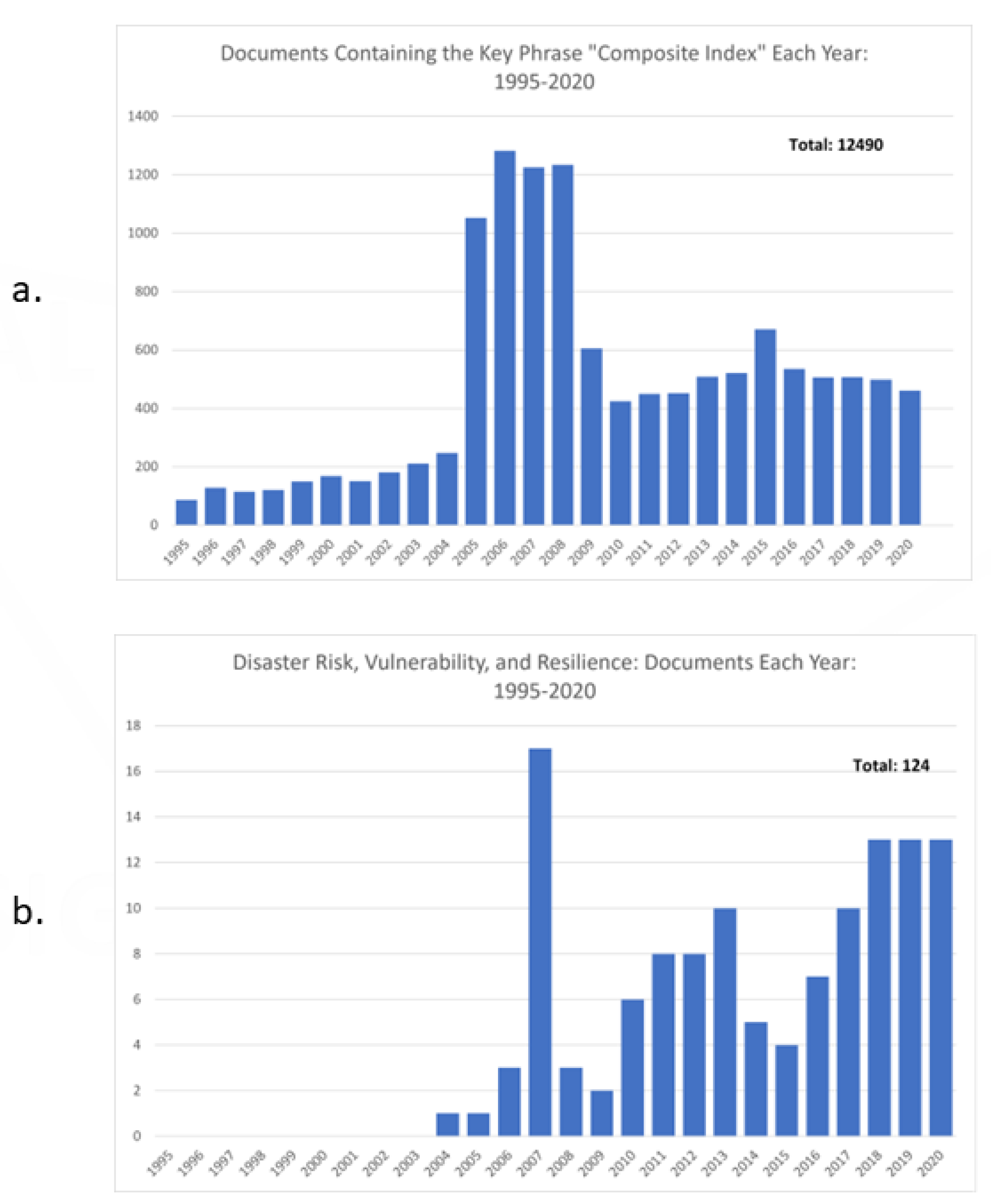
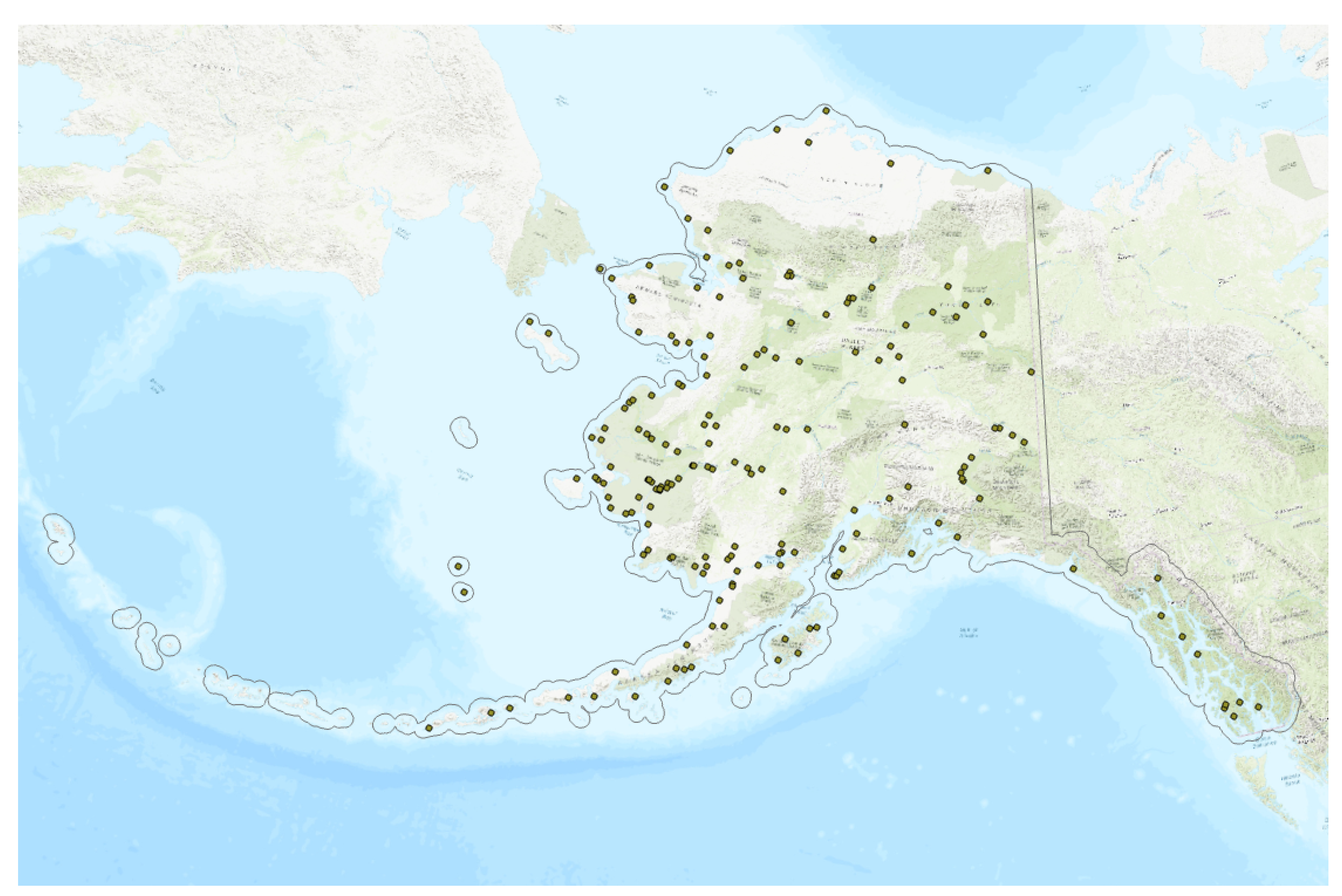
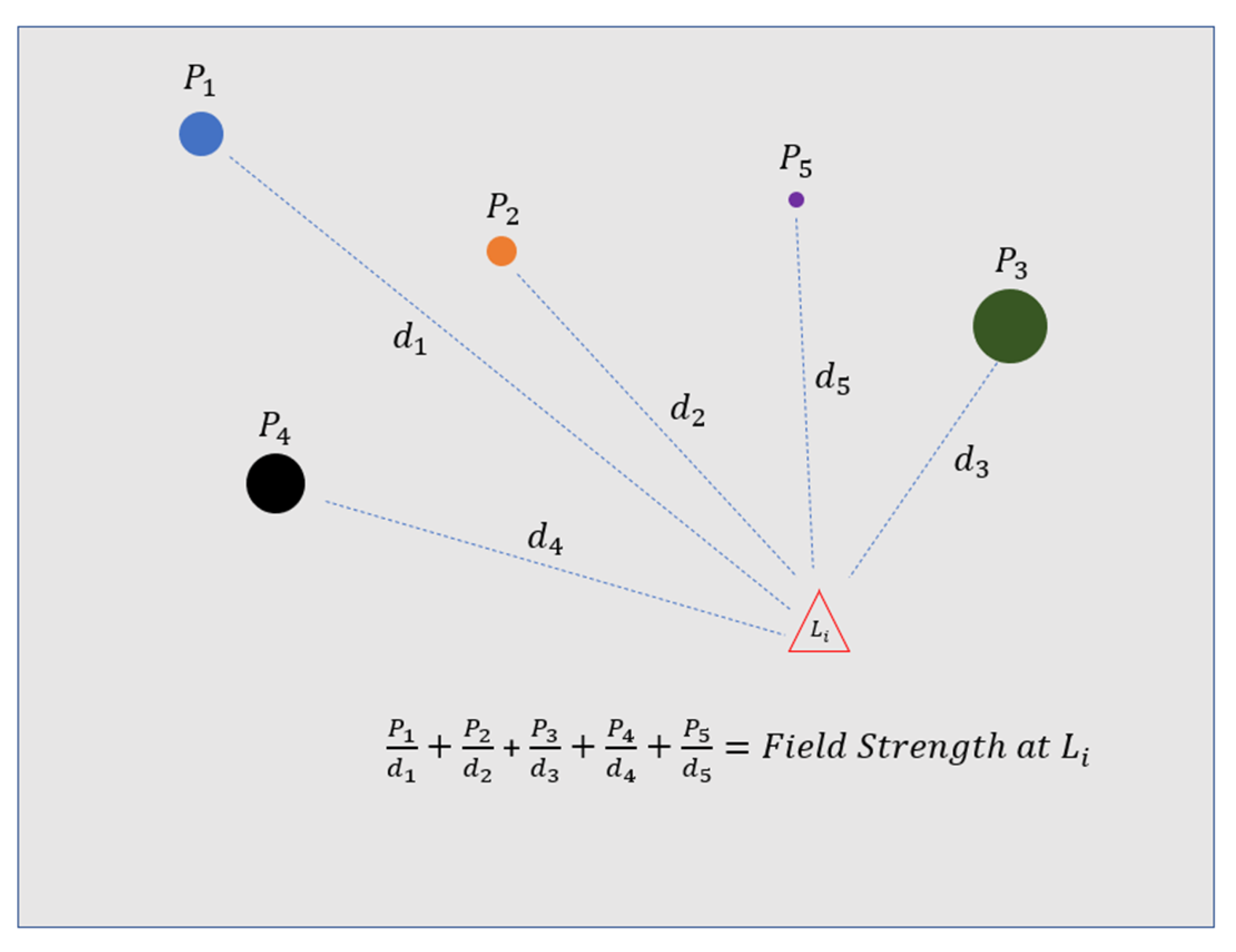
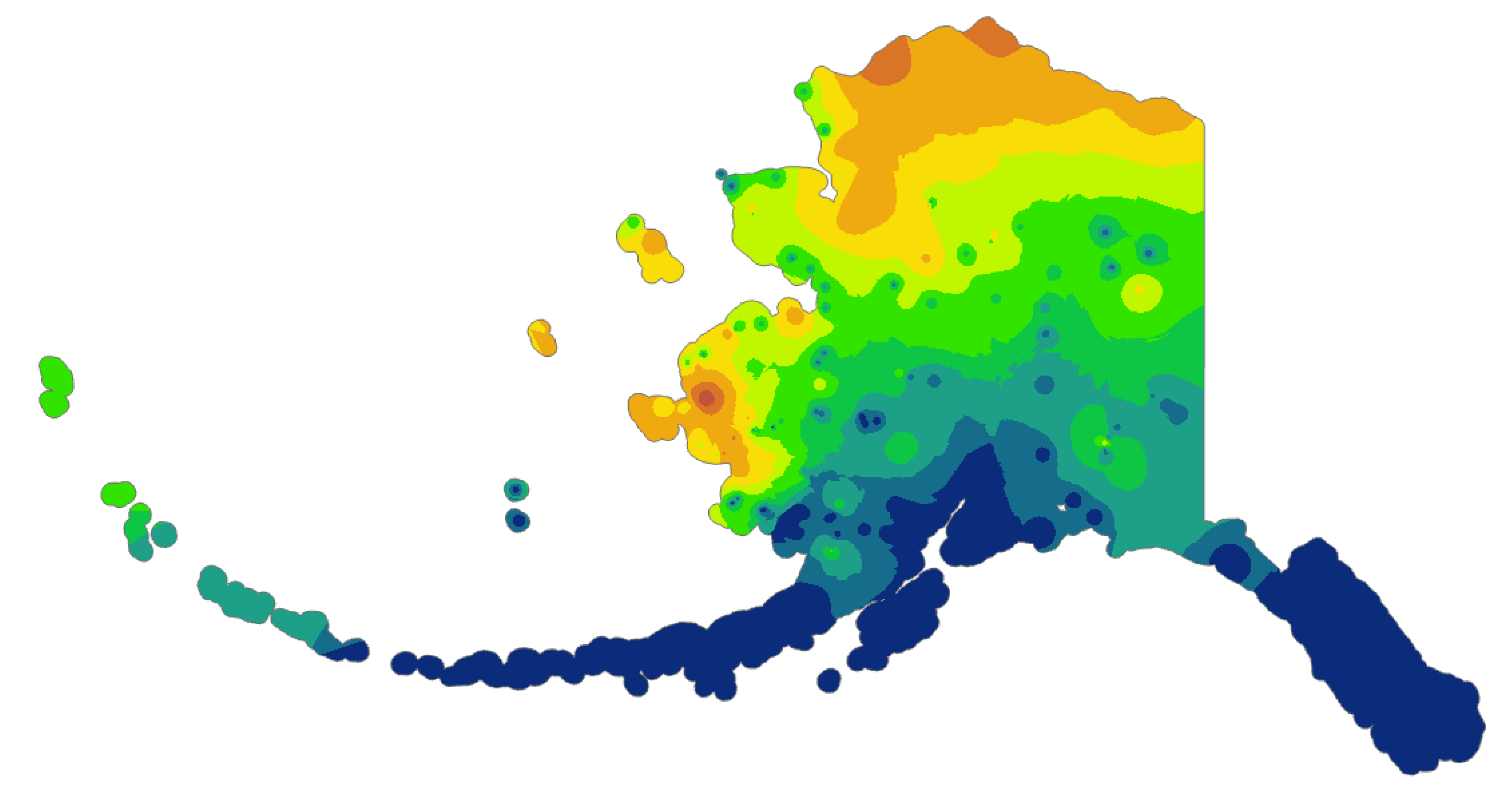

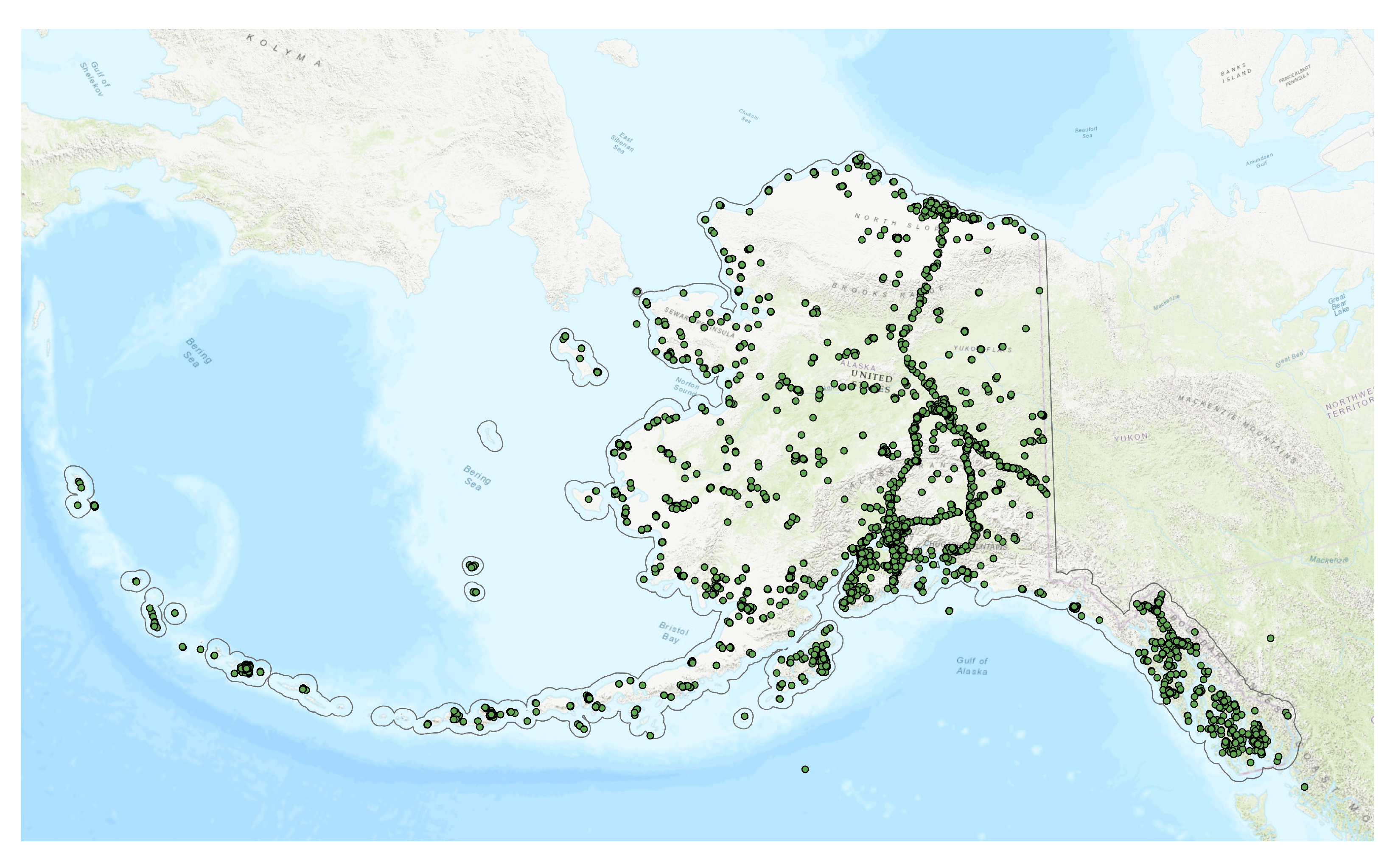
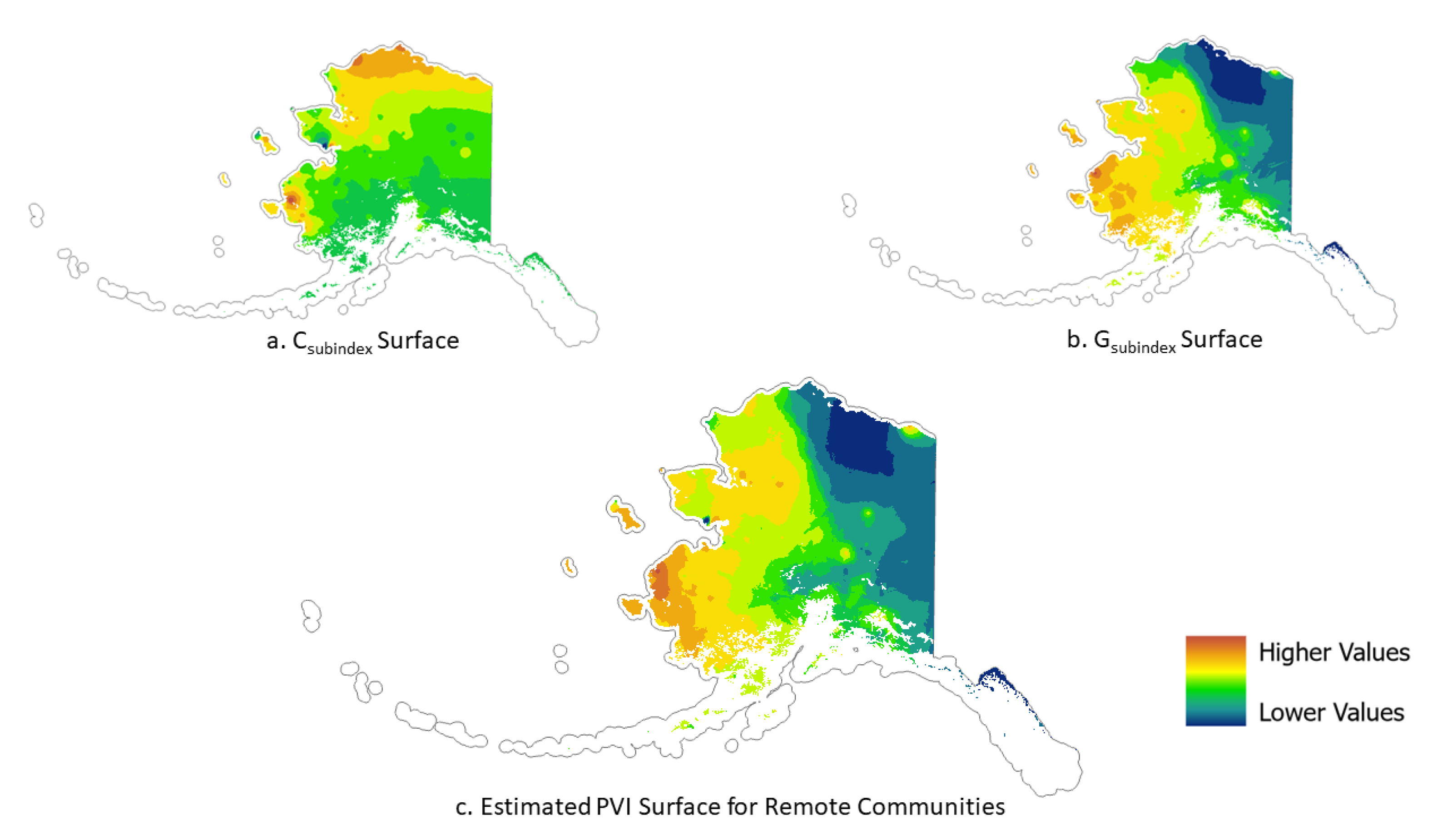

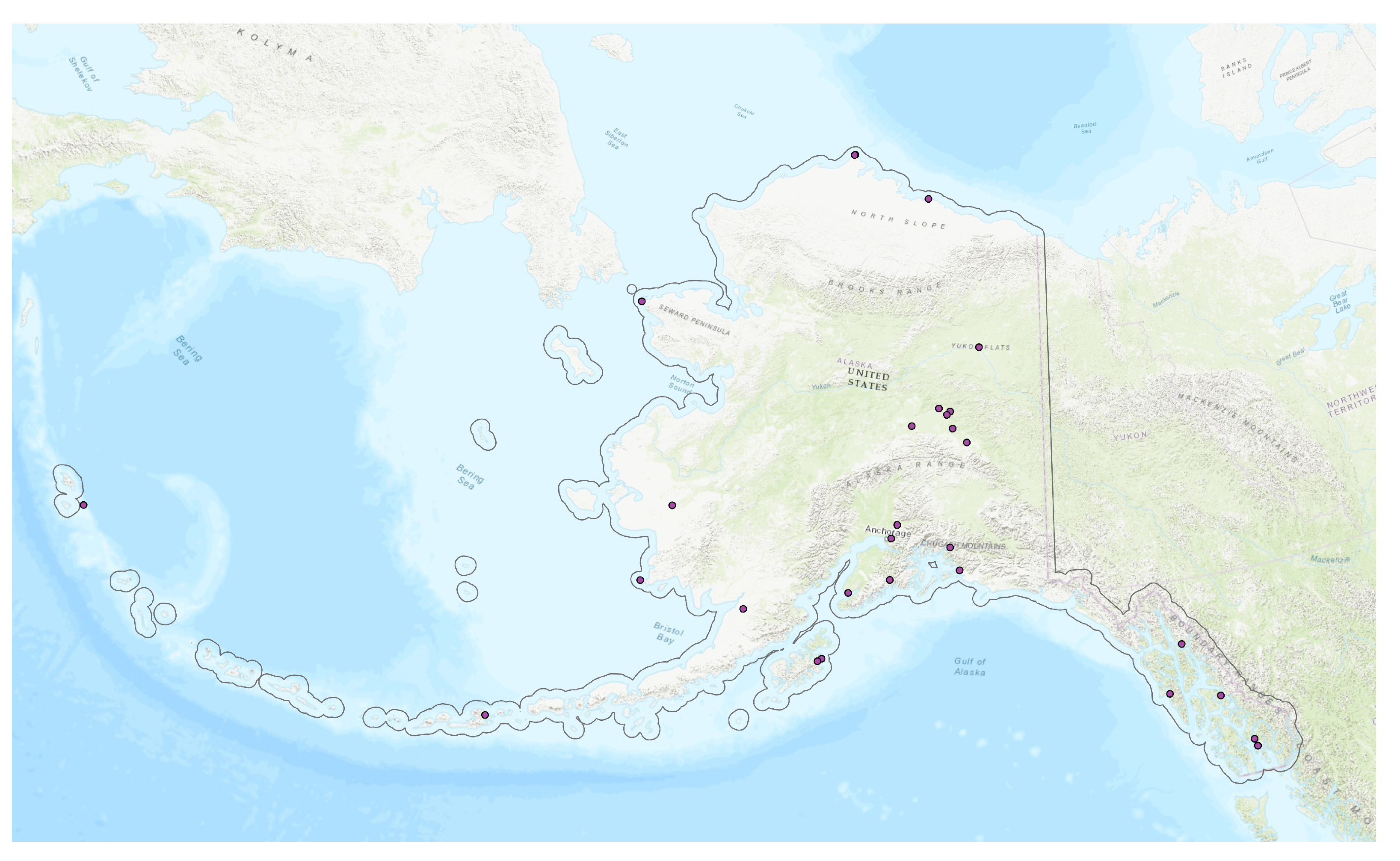
| Physical Subindex | Social Subindex |
|---|---|
| Natural Supply | Knowledge Capacity |
| Municipal Supply | Collective Community Capacity |
| Water Quality | Institutional Capacity |
| Permafrost | Cultural Capacity |
| Subsistence Habitat | Mobility |
| Categories | Types |
|---|---|
| Communications | Microwave Towers, Post Offices, Cell Phone Towers |
| Transport | Airports, Ports and Harbors, Ferries, Roads |
| Services | Fire Departments, Health Services, State Troopers, Emergency Operations Centers |
| Water | Dams, Wastewater, Water Treatment Facilities, Water Distribution |
| Energy | Bulk Fuel, Oil Facilities, the Trans-Alaska Pipeline System, Power Lines |
| Waste/Pollution | Contaminated Sites, Landfills |
| Infrastructure | Weighting Criteria | Weights Assigned |
|---|---|---|
| Airports | None | Same weight for all locations |
| Docks | None | Same weight for all locations |
| Bulk Fuel Tanks | Capacity | The capacity of the tanks (min = 600, max = 1,786,590) |
| Cell Towers | None | Same weight for all locations |
| Contaminated Sites | Type (1–5) | 1, 2, 3, 4, or 5 |
| Dams | Normal Storage | Normal storage of the dam |
| Power Transmission Lines | Voltage | Voltage (min = 7.2, max = 238) |
| Emergency Operations Centers | None | Same weight for all locations |
| Fire Departments | None | Same weight for all locations |
| Medical Facilities | Number of different certifications (up to 5) | 1, 2, 3, 4, or 5 |
| Landfills | Type (1–4) | 1, 2, 3, or 4 |
| Microwave Towers | None | Same weight for all locations |
| Oil Refineries | None | Same weight for all locations |
| Ports and Harbors | None | Same weight for all locations |
| Post Offices | None | Same weight for all locations |
| Roads | None | Same weight for all locations |
| State Ferry | None | Same weight for all locations |
| State Troopers | None | Same weight for all locations |
| Trans-Alaska Pipeline System (TAPS) | None | Same weight for all locations |
| Wastewater Treatment | System Class (1–5) | 1, 2, 3, 4, or 5 |
| Fresh Water Treatment | System Class (1–5) | 1, 2, 3, 4, or 5 |
| Water Distribution System | System Class (1–4) | 1, 2, 3, or 4 |
| Metric | Mean Difference between Calculated and Estimated Surface Values | Standard Deviation of the Difference between Calculated and Estimated Surface Values |
|---|---|---|
| Denali Scores | 0.00001 | 0.005 |
| AWRVI Scores | <0.00001 | 0.001 |
| Infrastructure Scores | 0.00123 | 0.0316 |
| Significance Level | Number of Communities |
|---|---|
| = 0.05 | 14 |
| = 0.10 | 26 |
| = 0.20 | 39 |
Disclaimer/Publisher’s Note: The statements, opinions and data contained in all publications are solely those of the individual author(s) and contributor(s) and not of MDPI and/or the editor(s). MDPI and/or the editor(s) disclaim responsibility for any injury to people or property resulting from any ideas, methods, instructions or products referred to in the content. |
© 2023 by the authors. Licensee MDPI, Basel, Switzerland. This article is an open access article distributed under the terms and conditions of the Creative Commons Attribution (CC BY) license (https://creativecommons.org/licenses/by/4.0/).
Share and Cite
Alessa, L.; Valentine, J.; Moon, S.; McComb, C.; Hicks, S.; Romanovsky, V.; Xiao, M.; Kliskey, A. Toward a Permafrost Vulnerability Index for Critical Infrastructure, Community Resilience and National Security. Geographies 2023, 3, 522-542. https://doi.org/10.3390/geographies3030027
Alessa L, Valentine J, Moon S, McComb C, Hicks S, Romanovsky V, Xiao M, Kliskey A. Toward a Permafrost Vulnerability Index for Critical Infrastructure, Community Resilience and National Security. Geographies. 2023; 3(3):522-542. https://doi.org/10.3390/geographies3030027
Chicago/Turabian StyleAlessa, Lilian, James Valentine, Sean Moon, Chris McComb, Sierra Hicks, Vladimir Romanovsky, Ming Xiao, and Andrew Kliskey. 2023. "Toward a Permafrost Vulnerability Index for Critical Infrastructure, Community Resilience and National Security" Geographies 3, no. 3: 522-542. https://doi.org/10.3390/geographies3030027
APA StyleAlessa, L., Valentine, J., Moon, S., McComb, C., Hicks, S., Romanovsky, V., Xiao, M., & Kliskey, A. (2023). Toward a Permafrost Vulnerability Index for Critical Infrastructure, Community Resilience and National Security. Geographies, 3(3), 522-542. https://doi.org/10.3390/geographies3030027









